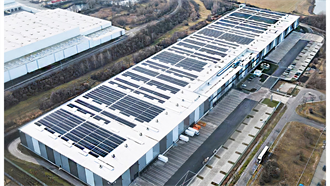Humancentric drives, a pillar of environmental, social and governance (ESG) programmes in real estate, have transformed the traditional big box industry.
Today both landlords and occupiers are thinking hard not only about how staff can reach a site, but what will keep them there. But making logistics assets amenity rich or more comfortable for their end-users isn’t just about ticking boxes on the road to certification. Today, it can mean the difference between attracting the right talent – crucial in the current tight labour market – or facing a staffing crisis. ‘Labour shortages are a key issue facing warehouse occupiers today,’ says Polly Troughton, managing director of St Modwen Logistics. ‘They are driving a revolution in warehouse design.’
Worker wellbeing – which encompasses everything from incorporating more natural light into developments to connecting with public transport and providing canteens – has become big business. It can range from schemes which plot basketball courts on their roofs, or extended public footpaths and leisure areas in their landscaping, to projects that even provide worker housing (see page xx).
Adds Lisa Graham, head of EMEA research for logistics and industrial at JLL: ‘The availability of skilled labour has become one of the main priorities for occupiers when making location decisions. When considering a site, they will ask where labour will come from, what other warehouses are competing for that talent pool, and what the cost of that labour is.’
Supply-side pressures
All this means that the human factor is increasingly becoming an expensive headache. When war broke out in Ukraine, hundreds of warehouse workers left Poland to join the war effort, adding to supply-side pressures in CEE markets. Meanwhile, in the UK, where around 20% of warehouse employees have been EU migrants to date, a new points-based system post-Brexit may deter that worker influx.
Other European territories experiencing record low unemployment are also seeing workers shop around for the best opportunities – which are not always a question of money. Indeed, the sector continues to battle against another issue – its reputation. Apocryphal stories about Amazon workers not being allowed toilet breaks aside, much warehouse work can be physically tough, leading to burnout.
Prologis research notes that high employee turnover can also result from the number of competing firms in the market, allowing workers to often leave and join a rival warehouse operator. The same Prologis report advises occupiers to prioritise aspects such as safety, flexible working schedules, competitive pay and benefits, plus practical aspects such as ergonomic workstations and equipment. Yet despite industry attempts to step up, shortages remain.
Enter the robot
Enter robotics and automated technology. While automation still requires human input, the physical burden is often eased, and warehouses can often still operate even with a reduced workforce. Robotics can also help contribute to rising pressures to deliver at speed, as competition around delivery windows intensifies.
According to JLL research, some 80% of warehouses worldwide still have no automation, suggesting a clear and growing opportunity. Yet issues remain around who funds the significant investment needed to create tech-led warehouses, as occupiers push back on always shouldering the fit-out costs.
Globally, the warehouse automation market is expected to reach US$41 bn by 2027, according to LogisticsIQ’s latest 2022 market report. A 2020 study by Prologis found that automation can boost revenue by between 10% and 20% per square foot of logistics space for e-commerce operations.
Knowledge is king
Part of the issue around funding automation is that third party logistics providers (3PLs) and occupiers are faced with a lack of choice when seeking finance providers, JLL suggests. The specialised nature of the warehousing industry means not everyone has the knowledge and therefore the confidence to fund and finance progress. While the likes of global asset finance partner DLL can arrange equipment finance, there are few options for those seeking to upgrade their warehouses with new tech and robotics across countries and locations.
‘The challenge is finding international players able to match global, cross-border ambitions,’ says Marcel Reinhardt, global head of supply chain financing at Miebach Consulting. ‘There’s a real need for expertise across countries which can take a view on the sector and finance the warehouses of the future. The sector is really seeking a financial instrument to solve a practical issue.’
While automation costs are steep today, there is hope that the industry’s evolution will reduce prices. In the meantime, tech and automation have become a precious tool in improving efficiency and achieving scale, crucial in a time of high energy prices and an onus on hitting ESG targets. At the end of the day, both landlords and occupiers may have to get their heads together to solve the problem.
Many warehouses have already bitten the bullet, employing technologies such as roaming shuttles and autonomous mobile robots (AMRs). But to date, these tools still require human input. Yet, even that may change. The world’s second largest clothing chain Uniqlo recently chose to go fully automatic. When asked about the impact on the workforce, Issei Takino, the CEO of Uniqlo’s chosen robotics provider Mujiin Robotics, said in the case of warehouses, ‘there are no humans to steal the jobs from because the workers just aren't there’.
Levelling up with logistics jobs
Polly Troughton, managing director of St Modwen Logistics, is on a mission to redress misconceptions about the warehouse industry. St Modwen, which has one of the UK’s largest logistics development pipelines, is aiming to grow its portfolio to over £1 bn in the next three years; to do that, it must hasten permitting by collaborating with councils that have sufficient vision to welcome new schemes. Yet Troughton frequently encounters what she calls a ‘lack of awareness about what the industrial and logistics sector can do and has done in terms of creating jobs’.
Troughton adds: ‘Local authorities want to generate employment opportunities, and they think they want offices, because they believe that’s where the better class of jobs come from,’ she notes. ‘White collar jobs appear to be better opportunities for a community than jobs within a warehouse; however, that’s not necessarily the case.
‘We have recently seen an evolution of the variety of jobs in warehousing – including everything from marketing to tech innovation. In fact, average salaries in the logistics sector are now higher than the average salary in the UK.
‘The sector has been completely undersupplied, which has actually supressed UK GDP. Many more jobs could have been created had the planning system facilitated greater development of warehouses. It all comes back to a lack of understanding about the need for warehousing in any built-up area. If you build homes you need jobs; and every one of those homes is going to need to receive parcels and delivery couriers. Large scale development also unlocks infrastructure in a massive way, so it also improves the ability to deliver to homes.’
In the UK, where a government-led ‘levelling up’ agenda is seeking to erode north-south disparities, Troughton argues that warehousing could play a larger role in this. ‘We are trying to communicate the sector’s potential to the government. Stoke on Trent, which sits in the UK’s logistics ‘Golden Triangle, is a great example of where developments like ours have contributed to the city’s regeneration, and we are seeing similar effects in the north east of the UK and Wales, where it plays an increasingly important role in the community.’



































